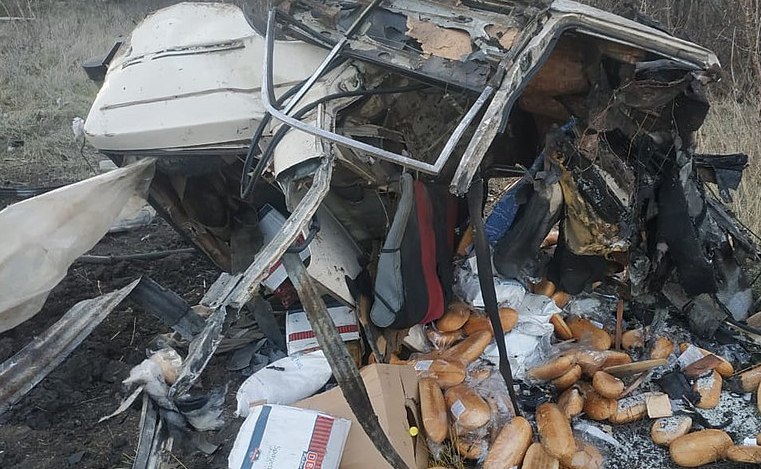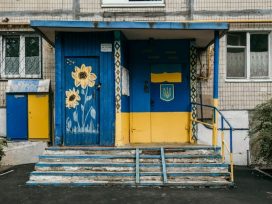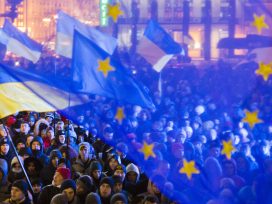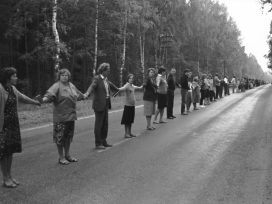Defending territory in war expands beyond physical frontlines to include cultural ground. Reclaiming signature dishes, language and public space contests their colonial assumption. Upholding traditions and retaining small home comforts takes on greater significance.
‘The old men confused the events and battles of the last war with those of preceding ones,’ wrote Ismail Kadare in his 1963 novel centred around the exhumation of fallen soldiers almost twenty years after the end of Second World War. Many older Ukrainians have a similar problem making such distinctions in the midst of war, given the broad palette of examples they have for comparison. They remember the Great Famine, the Second World War, the post-war famine, Afghanistan, the gangster wars of the 1990s. Many have moved several times, beginning with exile from western Ukraine to Siberia and ending (if they survived) with returning to remote villages in southern Ukraine or another Soviet Republic.
These days, elderly residents of Irpin sit on benches under shelled oaks. They compare how it was in 1941 to how it is now. I remember how one of my grandmothers would tell me stories about Hitler’s accomplices from Hungary during the Second World War and how they behaved in the worst possible manner toward locals in western Ukraine. My other grandmother, who lived just 15 km away, would express her disgust at Soviet ‘liberators’. Both women had their own unique perspectives on the bloody history they had lived through .
A 96-year-old man who survived the Nazi Buchenwald concentration camp died in March 2022 from a Russian missile in Kharkiv. His death not from old age but from war is a harsh rebuttal. Elderly people are fonts of memory: they recall the queues for basic necessities in Soviet times; know the recipes they cooked during the famine; remember the old cafés located where new apartment blocks stand; recount stories about banned books and censorship; retell how the intellectual elites were arrested. They are testament to Ukrainian cuisine, literature, architecture and art being connected.
Traditions under duress
Ukraine’s ongoing instability is clearly reflected in its culture, architecture, even gastronomy. Understanding that traditions are important to cultural memory and national identity, Ukrainians do what they can to save their customs in troubled times. On Christmas, I went to the frontline at Huliaipole to write about the traditional feast now celebrated in times of war. Before leaving Kyiv, I prepared kutia (boiled wheat with honey, poppy and walnuts) and uzvar (a compote made from dry plums, pears and apples). These dishes are a definitive part of the Ukrainian Christmas table, in all regions. Surprisingly, the soldiers had also already prepared these dishes. They even had a mushroom soup traditional in the Carpathians. The commander said: ‘We are celebrating this Christmas on principle’. Combatants not only prepared festive dishes but also sang carols under constant air strikes. I recalled the stories of Ukrainians who were deported to Siberia by the Soviets. Even there they had kutia and uzvar.
I was in Bakhmut for the New Year. There the military also followed gastronomic traditions – even those that are often criticized in Ukraine now. They prepared olivie salad, for instance, which many dislike because it contains mayonnaise, used during soviet times to give recipes an air of foreign sophistication while masking the flavour of substandard ingredients in soviet times. Even so, recreating a dish from their childhood brought some normality to their wartime lives. Volunteers took their salad to the basements where civilians were hiding.
Before midnight one of the colonels wanted to show me and my photographer colleague something. We went to the central square of Bakhmut where he had positioned a New Year’s tree. He asked us not to post images of it on Instagram because Russian soldiers would follow the trace and strike. We went back to the soldiers who had set up a barbeque, familiar worldwide, to cook veal.
When discussing the most stereotypical Ukrainian dishes and alcohol from an external perspective, one thinks of salo (cured pork fat) and horilka (similar to vodka). But Ukrainian traditional food and drink isn’t well known around the world. Neighbouring countries have appropriated cultural signatures.1 Borsch is a prime example; Russians have claimed the dish as their own. Pocketing these recipes may seem trivial, but it highlights a much deeper issue. The seat of a former empire will often appropriate or even eliminate the cultural markers of its once colonized nations.
France is well known for its aged wines and cognacs, Scotland for its whiskey, the United States for bourbon, all of which can take decades to mature. Horilka, on the other hand, is made relatively quickly: the whole process, from fermentation to bottling, taking just a few weeks.
When it comes to meat products, Spanish jambon and Italian prosciutto, both renowned ingredients, take months to mature. Ukrainian salo, on the other hand, preserved in salt, takes only three days to make. Ukrainians mostly boil or smoke sausage and ham, which doesn’t require aging and only takes a few hours to prepare.
Making cheese is even more simple: there’s no Roquefort or Parmesan that takes months to mature; most Ukrainians eat cottage cheese, which can be made from sour milk in just a few minutes.
Feast and famine
In the early twentieth century, Ukraine responded to the world’s need for grain. Due to the country’s high soil yields, its agrarian business became one of the leading in the world and farmers became rich. Even the First World War, the October Coup and the revolution of 1917-22 weren’t catastrophic for business. However, from 1928 Soviet collectivization turned private farms, which had been managed successfully, into kolkhoz. Farmers were deprived of grain, livestock and other means of subsistence, alongside their businesses. When collectivization increased dramatically in 1932, a man-made famine led to the death of several million Ukrainians. Those who survived have many psychological complexes. They manifest, for instance, in the conviction that throwing bread on the ground is a sin (in the Christian sense). Also, someone is considered wasteful if they leave food on their plate. It’s common to say they ‘haven’t seen famine’, implying that they haven’t learned from history.

A civilian car blown up by an unknown explosive device in Izium Raion, Kharkiv region, Ukraine, 1 December 2022. Image via Wikimedia Commons
Chekists ran collective farms. The supporters of collectivization, who took everything from others and shared it amongst themselves, were the least economically minded and hardworking people; they didn’t succeed nor did they display any desire to do so. In other words, the biggest villains and idlers took away the property of the greatest toilers. Tell me if a farmer can afford to store a three-year-old ham or a ten-year-old whiskey in such conditions?
High-end shortforms
The situation was the same in the artworld. In the 1920s and 1930s, an esteemed group of writers, directors and translators produced material in Ukrainian, focusing primarily on the European cultural scene. They quickly filled open niches, creating detective stories, non-fiction, science fiction, etc. Each writer practiced several genres in their haste to sow the field of culture. One of the group’s leaders Mykola Khvylovy, who coined the expressions ‘away from Moscow’ and for ‘psychological Europe’, shot himself in the head on 13 May 1932 when he witnessed the famine in villages and discovered his friend had been arrested by the cheka. There was a wave of arrests, executions and public harassment of pro-Ukrainian intellectuals during the Stalin’s Great Purge. By the late 1930s, only a few of the Ukrainian cultural elite were still alive.
You will not find many epic novels in classical Ukrainian literature. Many works are outstanding, but there’s no tradition like Norse sagas from Scandinavia or weighty historical novels from the UK. Recently, there were literary criticism complaints that contemporary Ukrainian literature contains too many family sagas, suggesting that this tendency was getting dull. However, the period of independence was one of the few opportunities to write a great uncensored story about several generations under one cover.
Understandably, poets rather than prose writers are considered Ukraine’s strongest artists; a poem can be written both in a prison cell before an execution and in a shelter during an air raid. Vasyl Stus, for example, wrote several poetry books in jail, managing to produce them in Ukrainian.
Cultural backdrop to war
Everything needs to be resilient in times of war. I am writing right now in Kyiv at a beautiful café, which opened six years ago. The owners haven’t closed the place since the full-scale invasion started. When Russians soldiers were on the outskirts of Kyiv, the café covered its huge glass windows – that’s all. At any moment, the café might be destroyed. Nothing transmits a sense of permanence in Ukraine due to the constant wars and reprisals over the last 350 years under the repressive colonial politics of the Russian Empire, the Soviet Union and the Russian Federation.
Since 1991, and more intensively from 2014 when the active process of decolonization began, many important cultural changes have taken place in Ukraine. It’s culture has gained an international audience: new state-supported films have featured at Cannes and the Berlin festival; fresh Ukrainian literature has been published in dozens of world languages; the country’s contemporary music is making its way into the world charts. However, it is impossible to make movies during air strikes. It’s difficult to make theatrical performances, write novels and rent premises in times of war.
An acquaintance of mine, a musician who is currently in Brittany, France, sends me photos from their tour: beautiful 500-year-old towns with integral historic buildings and modern amenities. In response, I sent her a photo from Kyiv, the monuments covered in protective plywood. I look at pictures of monuments in front of churches from the tenth century surrounded by new houses. In Ukraine, there are many monuments that have exceptional value, but there are few integral architectural sites, only remnants of what didn’t burn during the First and Second World Wars, after the Mongol invasion, after the deliberate blasting of churches by the Communists and, now, after further Russian shelling.
Time to mature
The story of my grandfather’s brother comes to mind. Before the Soviet authorities sentenced him to forced labour in the Donbas coal mines for participating in the Ukrainian Insurgent Army, he buried a bottle of horilka in his garden. When he returned home fifteen years later, he dug up that treasure from under the apple tree. People said that the liquid had a bluish tinge and was very tasty. Perhaps, in other circumstances, my grandfather’s brother could become a successful businessman, an innovator in the alcohol trade.
Similar processes take place in the arts: Mykola Gogol and Kazimir Malevich have been represented as Russian artists; large parts of the Hermitage Museum, St. Petersburg, and the Tretyakov Gallery, Moscow, consist of art from Russian occupied countries.
Published 17 May 2023
Original in English
First published by Eurozine
Contributed by Institute for Human Sciences (IWM) © Myroslav Laiuk / Institute for Human Sciences (IWM) / Eurozine
PDF/PRINTIn collaboration with
In focal points
Newsletter
Subscribe to know what’s worth thinking about.
Related Articles

The ‘Trump–Putin deal’ again places Ukrainians in a subaltern role. The leaked contract with its fantasy $500 billion ‘payback’ has been compared to Versailles, but the US betrayal recalls nothing so much as Molotov–Ribbentrop.

Ukraine faces its greatest diplomatic challenge yet, as the Trump administration succumbs to disinformation and blames them for the Russian aggression. How can they navigate the storm?






